It’s winter in Maryland. In fact, it’s so much winter I shoveled 10 inches of snow off my driveway this morning. Fortunately, I had company. It wasn’t the kind of company that picks up a shovel and helps out, but still, the American robins darting back and forth over my head were still welcome (if surprising and surprisingly quiet) snow day companions.
Become a Member
Make a lasting impact for nature when you join The Nature Conservancy
“You know,” I said to them as I leaned on my shovel to watch about 25 birds flock together in my neighbor’s oak. “I think y’all are a little early—aren’t you supposed to be the first harbingers of spring?”
We’re not even a month past the first day of winter in the northern hemisphere. Spring is definitely not here. So why are the robins? Shouldn’t they be sunning themselves in warmer climes?
The short answer: as long as there’s food, American robins—true to their name Turdus migratorius (“the wandering thrush”)—kind of spend their winters coming and going as they please.
Robin Migration (AKA Robin Wandering)
Robins do migrate—but they don’t necessarily follow a more or less straight line from north to south in the fall, then repeat the journey south to north in the spring. In the fall and winter, when the ground freezes, robins lose access to their meal of choice: worms, insects (adult and larval) and (occasionally) snails. That’s when they turn to their winter diet staple: mostly fruit, mostly berries.
The folks at Journey North, a project tracking robin movements run by the University of Wisconsin-Madison, put it this way, “Some robins retreat all the way to southern Texas and Florida (in fact, some of the largest winter flocks documented by the Christmas Bird Count gather in sunny St. Petersburg, Florida), but others winter as far north as they can find berries. So they have an enormous winter range. Robins do migrate, but it has more to do with food sources than with being faithful to the same places year over year.”
In that way American robins are somewhat akin to teenage boys—they tend to go where the best (or most abundant or most easily accessible) food is, stay until it’s depleted, and then move on.
So as long as there are enough berries and other fruits to sustain them, you may see robins off and on throughout the winter across much of North America.
Forget the birdseed though. Robins’ digestive systems, unlike sparrows or other so-called feeder birds, aren’t built for dealing with seed, and their beaks aren’t built for cracking things open. Robin beaks are built for snapping up worms, catching insects, and plucking berries and other fruits. In the winter, a flock of robins can strip a holly bush with impressive speed and efficiency, and very little—if any—violent robin-on-robin aggression.
Food is also one of the reasons that robins, notoriously territorial and aggressive in breeding season, tend to gather and travel in flocks in the fall and winter. Numbers are good for defense, and also for spotting food—if one robin happens on a holly tree full of bright, ripe berries, the whole flock can partake. And then move on.
The tendency of robins to flock in winter may also be one of the reasons people seem to notice them—birds in large numbers tend to stand out when they’re gathered in leafless trees. (That and the beautiful red breast that is sometimes the only splash of color in a winter landscape that looks practically lunar in relentless shades of February white and gray.)
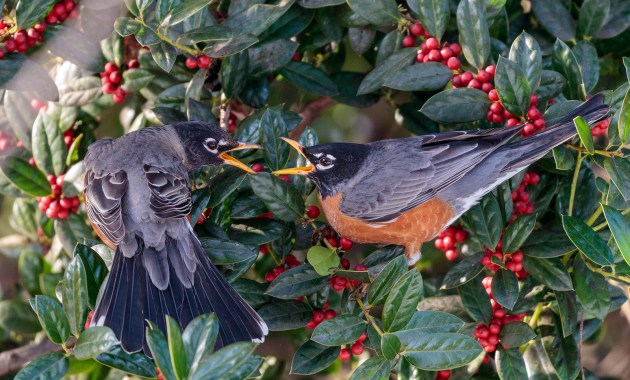
How do Robins Survive the Cold?
Robins are outfitted to survive huge temperature variances. In fact, hot weather seems to stress them more than cold.
If an American robin is healthy, has enough to eat, and is able to main its feathers, the temperature next to its body stays around 104 F—regardless of how cold it is in the world outside. It really is all about those feathers. (And the legs and feet.)
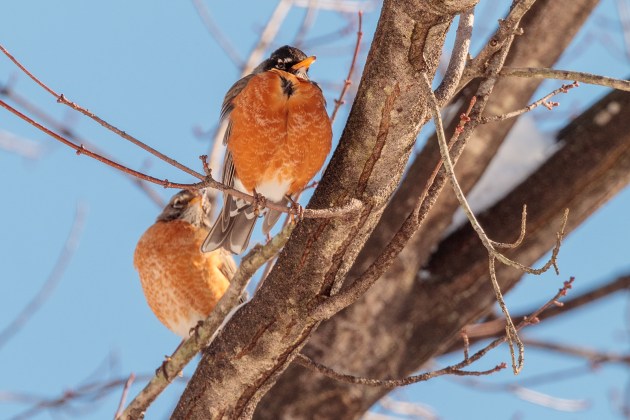
Robins, like most birds, have layers of feathers that perform different functions. When temperatures drop, robins puff the fine, downy feathers closest to their bodies to keep heat in, cold out. The outer feathers act like a kind of overcoat, shedding water and moisture and helping to regulate the bird’s temperature. (It’s an adaptation not limited to robins. Most birds with down feathers fluff them to regulate body heat).
The anatomy of a robin’s (and other bird species) also contributes to their cold adaptations. The bird experts over at the Cornell Lab explain it very well. The simplified version is that “most birds don’t succumb to frostbite because there is so little fluid in the cells of their feet, and their feet are mostly tendons and bones with little muscle or nerve tissue.”
So while blood does flow to their legs and feet, most birds (including robins) benefit from a very fast circulatory system and a “countercurrent heat exchange system.” Because bird legs are thin, the vessels that move blood from the heart to the feet and back again are very close together. That proximity means, per Cornell, “blood flowing back to the body is warmed by blood flowing to the feet. The newly cooled blood in the feet lowers heat loss from the feet, and the warmed blood flowing back into the body prevents the bird from becoming chilled.”
Robins: The Tell-Tale Birds of Spring
If robins are around in winter, why have they always been associated with the beginning of spring in the U.S.? Most likely it has to do with ground thaw, snow melt, and territorial behaviors like singing, worm hunting and nest building. But mostly, it’s the singing.
According to Journey North, which has a fantastic Q+A section I highly recommend for the robin-curious, “the robin’s song remains a reliable indicator that the first wave of spring migration has reached you. This song is one of the first signs that robins are switching from winter behavior to courtship and nesting behaviors associated with spring.”
Robins tend to move north as the ground thaws. The availability of high protein prey, especially worms that emerge with warmer, often wetter weather, is when a robin’s thoughts turn to procreation. And that’s the end of the cooperative fall and winter behaviors.
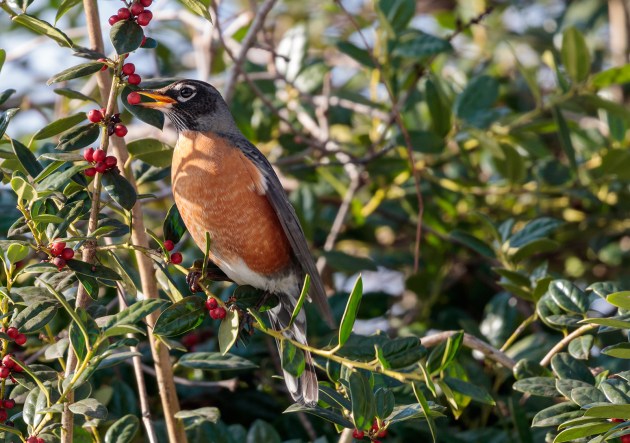
Which is one of the reasons many robins (primarily males) may stay through harsher winters instead of booking it to St. Petersburg: first access to the choicest nesting grounds. Breeding season is when robins also become more visible with mating displays, nest-building and a lot of time on the ground hunting for the tastiest worms. Until then, they’re all about the berries.
You Can Help Robins with Science from Your Own Backyard
Like many species, including other birds, scientists are starting to see some changes in robin behavior that is likely attributable to climate change. One study of American robins migrating to and from Canada’s boreal forest, showed that they’re beginning to journey south on average about 12 days earlier than in past years, or five days earlier per decade since 1994.
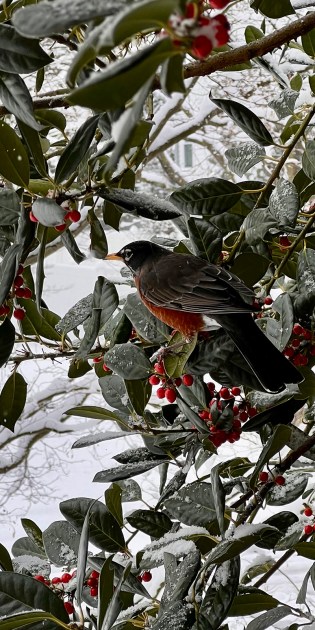
If you want to help scientists studying birds, there are several ways to contribute your observations (not just for robins, but for many of the species you can see outside your windows).
Journey North
You can submit your robin observations directly on the Journey North site (and check out their other migration-related citizen science projects). They also have 2025 maps tracking sightings so you can see where American robins (and other signs of spring) are being observed and follow along (and contribute to) the wanderings of Turdus migratorius.
Cornell Lab of Ornithology
The Cornell Lab has a number of different ways you can contribute to science for birds. Your sightings tracked on eBird (free) contribute to worldwide data for birding, science, and conservation. Want to know what birds are being seen in your neighborhood, eBird has a feature for that. If you’re new to birding, check out their genius birding ID app, Merlin.
You can also contribute to Project FeederWatch (requires subscription) by counting birds at your feeder from November through April. Your observations help scientists monitor changes in the abundance and distribution of birds, including the influence of changes in habitat, disease, and climate.
And mark your calendars for the 2025 Great Backyard Bird Count (February 14-17). Spend time in your favorite places watching birds—then report them to Cornell! It’s easy to participate, “in as little as 15 minutes notice the birds around you. Identify them, count them, and submit your counts to help scientists better understand and protect birds around the world. You can see the results from 2024 here.
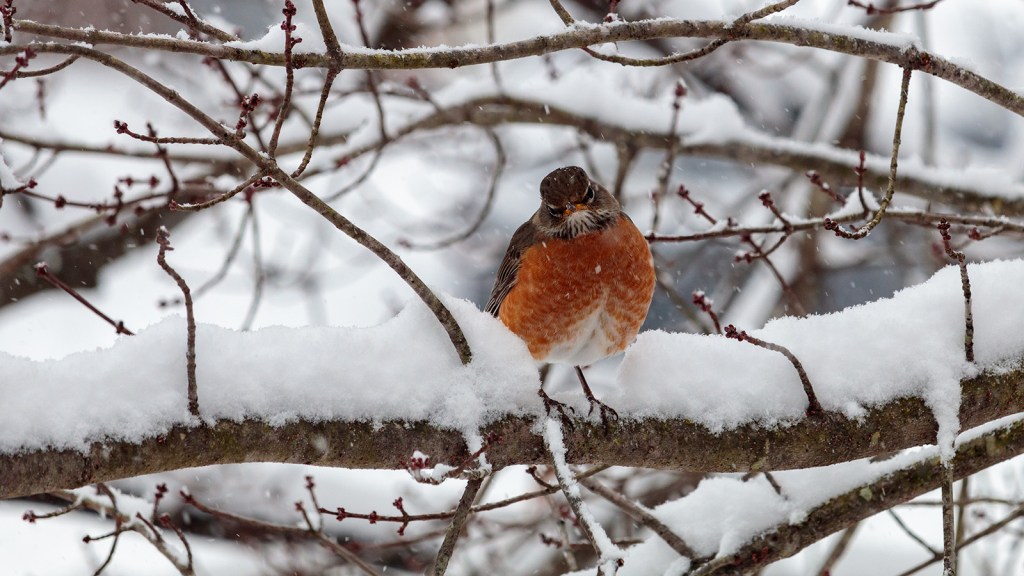



We’ve had HUNDREDS of big, fat robins eating all the berries from our holly bushes in the past week, they’ve been really busy. We’ve been putting water out but with our record-breaking cold weather (3’f this morning in Fort Worth, TX) it freezes before any robins notice it.
I’ve never before noticed flocks of robins in deep winter. Last week, skiing in a brushy area of the Fingerlakes Forest near the pond area, there were several robins, flying from shrub to shrub, calling to each other, eating the few remaining berries on these bushes. They were not at all troubled by our intrusion. As I’d never seen this before, I doubted they were robins, but the Merlin app on my phone suggested they were. Now I’ve read your site and am happy to have some new knowledge of the birds in our area in winter. Surprising!
We have been having flocks of deeply colored male robins for two weeks, They go for the berries on the Bradford pear trees. They come before a storm is predicted. Locally folks call them Canadian Robins,
location: Portland , ME last flock: Feb 12
We had a flock of about 30-50 of the most beautiful Robins visit our flowering crab apple tree. After reading I realize now they were all males. They were the biggest, fattest most robust Robins I’ve ever seen and I’m no spring chicken! It was just a day or two ago before this cold hit Oklahoma. It’s -1 now. I’m worried they’ll freeze! I’m so glad to read that their feathers were puffed up and they’re probably warm and safe. Thanks for the article ! I thought they had just way overeaten!
Had about 10-12 robins at my birdbath and friends reporting a lot of robins around our area. Arlington ,Tx
According to this, I’m seeing over-wintering robins. I’ve seen an increase lately, in general, but the last few days we’ve had severe, freezing, snowy, (unusual for us) winter weather. Today I’ve seen dozens, maybe even 100 or more in my yard, in the trees, on my front porch, eating seeds from outside plant—it’s been pretty great! I’m 5 miles into Oklahoma across the Arkansas River from Fort Smith, AR.
Tulsa Ok. Friday February 12th 2021 while looking out into my backyard from the sunroom I was in disbelief what I was seeing maybe 100 robins all over my garden. I was so excited and began taking pictures. We had about 1 /4″ of ice on the ground and extremely cold temperatures. I Jump into action got a container and offered water, I was so very happy what I was seeing about 13 Robin’s drinking at the same time 1 taking a bath some leave and others came. I thank God for this amazing privilege to see this beautiful site in my yard which lasted all day.refill the water 3xs .and the next day they were gone. Pictures available.
Temperatures are below zero and 23 below zero wind chill right now and I’m seeing huge gatherings of robins in my backyard and around the area.
The temp in southern Oklahoma is a record setting 10-0 degrees for the next week. There were 100’s ravaging my holly berry trees and bushes. They wiped out the red berries all around the house, which has never been done in the past 26 years that I have lived here. Beautiful to watch.
I live in South Oklahoma City, today’s temperatures never got up to 2 degrees. My back porch had ten to twelve Robins most of the day. They were very messy. Not sure where they were feeding but they sure left the remains behind. First time I’ve ever had so many Robins in one spot. They sat in the sun most of the day all puffed up and eating snow! It was interesting to read your post and explained why so many at one time. Thanks Karen Nydick
We have been seeing a larger number of robins than usual in Norman, Oklahoma. With the sub freezing temperatures we are having right now they seem to be present than usual. I had one out back the other day that was sure a little “chunky” trying to get inside a bush and having a hard time spotting a spot open enough to wiggle in! Thanks for your research into these beautiful birds.
Had six Robbins at my heated birdbath Feb. 14th. I live in Grand Haven Michigan along the lakeshore. I am curious as to what they are eating. I have no bushes with berries nor do I see them in the near vicinity of our house. I do live out in the country. Also, is there any thing I can put out for them that they will eat?
Literally more than 100 in the trees and sitting on the hedges close to my home. Harker heights, TX. They started showing up today, the morning after a night-long freezing cold snowfall.
Last week there hundreds of Robins that descended into my yard and trees. The next day there were less and now they are gone. It was below freezing and icy. I live in Muskogee, Oklahoma
It’s below zero with wind chill, but single digits during the day. Last week, 2/7-8 / 2021 saw the first robin in southern Wi. Caught totally off guard. Just don t know how this bird can survive these temps. Yesterday bird #2 arrived